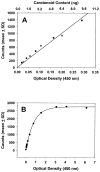Resonance Raman measurement of macular carotenoids in normal subjects and in age-related macular degeneration patients
- PMID: 12359594
- PMCID: PMC3079575
- DOI: 10.1016/s0161-6420(02)01173-9
Resonance Raman measurement of macular carotenoids in normal subjects and in age-related macular degeneration patients
Abstract
Purpose: Dietary carotenoids lutein and zeaxanthin may play a protective role against visual loss from age-related macular degeneration (AMD) through antioxidant and light screening mechanisms. We used a novel noninvasive objective method to quantify lutein and zeaxanthin in the human macula using resonance Raman spectroscopy and compared macular pigment levels in AMD and normal subjects.
Design: Observational study of an ophthalmology clinic-based population.
Participants and controls: Ninety-three AMD eyes from 63 patients and 220 normal eyes from 138 subjects.
Methods: Macular carotenoid levels were quantified by illuminating the macula with a low-power argon laser spot and measuring Raman backscattered light using a spectrograph. This technique is sensitive, specific, and repeatable even in subjects with significant macular pathologic features.
Main outcome measure: Raman signal intensity at 1525 cm(-1) generated by the carbon-carbon double-bond vibrations of lutein and zeaxanthin.
Results: Carotenoid Raman signal intensity declined with age in normal eyes (P < 0.001). Average levels of lutein and zeaxanthin were 32% lower in AMD eyes versus normal elderly control eyes as long as the subjects were not consuming high-dose lutein supplements (P = 0.001). Patients who had begun to consume supplements containing high doses of lutein (> or =4 mg/day) regularly after their initial diagnosis of AMD had average macular pigment levels that were in the normal range (P = 0.829) and that were significantly higher than in AMD patients not consuming these supplements (P = 0.038).
Conclusions: These findings are consistent with the hypothesis that low levels of lutein and zeaxanthin in the human macula may represent a pathogenic risk factor for the development of AMD. Resonance Raman measurement of macular carotenoid pigments could play an important role in facilitating large-scale prospective clinical studies of lutein and zeaxanthin protection against AMD, and this technology may someday prove useful in the early detection of individuals at risk for visual loss from AMD.
Figures






References
-
- Schalch W, Dayhaw-Barker P, Barker FM., II . The carotenoids of the human retina. In: Taylor A, editor. Nutritional and Environmental Influences on the Eye. Boca Raton, FL: CRC Press; 1999. pp. 215–50.
-
- Snodderly DM. Evidence for protection against age-related macular degeneration by carotenoids and antioxidant vitamins. Am J Clin Nutr. 1995;62(Suppl):1448S–61S. - PubMed
-
- Landrum JT, Bone RA. Lutein, zeaxanthin, and the macular pigment. Arch Biochem Biophys. 2001;385:28–40. - PubMed
-
- Snodderly DM, Brown PK, Delori FC, Auran JD. The macular pigment. I. Absorbance spectra, localization, and discrimination from other yellow pigments in primate retinas. Invest Ophthalmol Vis Sci. 1984;25:660–73. - PubMed
-
- Bone RA, Landrum JT, Fernandez L, Tarsis SL. Analysis of the macular pigment by HPLC: retinal distribution and age study. Invest Ophthalmol Vis Sci. 1988;29:843–9. - PubMed
Publication types
MeSH terms
Substances
Grants and funding
LinkOut - more resources
Full Text Sources
Other Literature Sources
Medical

